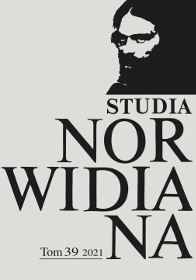Vade-mecum in the perspective of time. Topic outline
Abstract
This article addresses a conceptual and artistic issue that is vital for Norwid’s entire work, namely the relationship between time and movement. This question has preoccupied philosophers and poets since antiquity, giving birth for example to the ingenious concept of time-space developed by Alfred Einstein, and leading further to string theory, multidimensional physics, or noncommutative geometry. In the field of poetry, this theme has been elaborated in the myth of “eternal recurrence,”brilliant ancient Greek tragedies, Shakespeare’s dramatization of human fate as the temporal course of the inevitable consequences of compacts with evil (as in Macbeth), the piercing reinterpretation of the Passion in Mickiewicz’s psychomachia (in the third part of Dziady [Forefathers’ Eve]), the apocalyptic visions in Krasiński’s Nie- Boska komedia [The Undivine Comedy], and explorations of the (often allegorized) question of historical turning points in Norwid’s Quidam, which is set “between dawn and the fading of the night…”Finally, in philosophy, Hegel postulated the logical conclusion of history in his profound theory about the culmination of historical processes.
In Norwid’s poetry, images of movement in time are usually anchored in the sequence of events or in the consequences of concluding on the basis of articulated premises (as “movement of thought”). What is notable here is not the perspective of some indefinable transformation considered as the effect of anonymous processes, but rather the establishing of certain consequences of “unfolding,” which is often expressed in poetic terms as a surprising point that communicates an explicit or implicit “moral lesson,” sometimes as a result of supernatural intervention, as in the poem “XIV. Litość” [XIV. Mercy], where a sequence of ostensible or conventional signs of compassion are interrupted by a “bolt out of the blue,” demanding authentic help for our neighbour.
It is worth remembering that Vade-mecum is, to a large extent (if not essentially), a programmatic work on the one hand, while on the other – an authentic selection of poems written in the years 1848-1866 subjected to a specific programmatic function that foregrounds moral obligations as a poetic response to the vital needs of the times – an artistic gesture meant to offer an answer to the problems of this period. Hence the immense sense of a lack of fulfilment experienced by Norwid as an “extra actor” in the theatre of an age that Zofia Stefanowska called “the age of trade and industry.”
References
Norwid C., Vade-mecum, oprac. J. Fert,Wrocław 2003, BN I 271.
Berzeżyński K., Filozofia Cypriana Norwida, Warszawa 1911, odb. Ze „Sfinksa” 1911.
Borowy W., O Norwidzie. Rozprawy i notatki, oprac. Z. Stefanowska, Warszawa 1960.
Bieńkowska E., Dwie twarze losu. Nietzsche – Norwid, Warszawa 1975.
Lisiecka A., Norwid poeta historii, Londyn 1973.
Szestow L., Na szlakach Hioba. Duchowe wędrówki, przełożył J. Chmielewski, Warszawa 2003.
Herbert Z., Węzeł gordyjski oraz inne pisma rozproszone 1948-1998, zebrał i oprac. P. Kądziela, Warszawa 2001.
Musset A. de, Spowiedź dziecięcia wieku, przełożył T. Boy-Żeleński, Warszawa 1979.
Zygmunt Krasiński – nowe spojrzenia, red. G. Halkiewicz-Sojak i B. Burdziej, Toruń 2001.
Copyright (c) 2021 Studia Norwidiana

This work is licensed under a Creative Commons Attribution-NonCommercial-NoDerivatives 4.0 International License.





